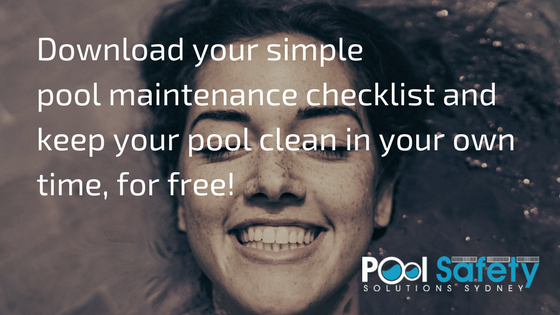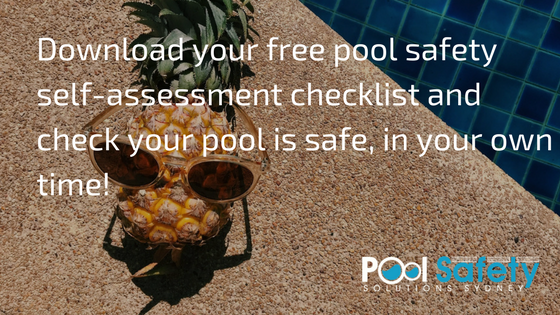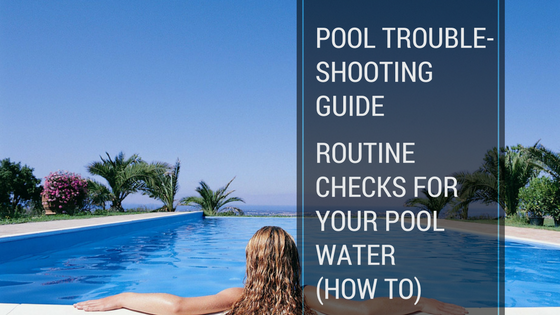You’ll find easy to use daily and weekly pool water checklists, answers to frequently asked questions about water testing, as well as links to download your free PDF swimming pool maintenance checklist and pool compliance self-assessment checklist.
I think you’ll agree with me:
Looking at a clean pool with crystal clear water is extremely satisfying.
If your pool water’s looking a little green or in need of some TLC, don’t give up yet!
Keeping your pool water consistently clean all starts with doing some essential daily, and weekly, checks…
… it really is as easy as dedicating a few moments every day to making sure your pool water is always looking its best.
In today’s post, I hope you find great value from our handpicked selection of essential routine daily and weekly checks for your pool water.
You’ll soon be able to consistently see an immaculate, clean swimming pool every day.
Oh, and before we get stuck into it make sure you download a free copy of your PDF pool maintenance and cleaning checklist, which might come in handy!
The first thing you probably want to know:
Keeping your pool water clean and safe starts with the basics; quick and simple daily checks.
By consistently carrying out these checks you will be able to ensure your swimming pool remains pristine and ready for use.
Here it is:
Pool Water Daily Checklist
This is a great daily checklist for your pool water that the PoolSSS team have used, and recommended, for years.
Simple 4 Step Pool Water Daily Check
Check your pool filter and pump
Do a quick check and make sure it’s all working correctly, and that your pool filter tank’s pressure gauge is giving a normal reading.
Make sure nothing is leaking in your plumbing and valves and ensure your pool pump and filter are operational for 8-12 hours a day.
Remember to follow manufacturer and your local pool shop’s advice when dealing with your pool hardware.
Now you know your equipment is functioning normally:
Check your pool for debris and foreign objects
Is there foreign debris from your pool surroundings in your pool water?
Giving your pool a quick skim, especially during months when foliage tends to drop frequently, will make sure you prevent any blockages from happening.
Remove any foreign objects from the surface, as well as any sunken pieces from the pool floor.
It’s an easy task to complete and can take no more than 5 minutes of your time.
Ok, your pool is looking clear of unwanted fallen debris:
Inspect your skimmer baskets and pump traps for blockages
You definitely want to make sure there is no organic build up in your skimmer baskets and pump traps.
Poor water circulation is one of the leading causes of a bloom of algae turning your pool into a murky soup.
Any leaves, falling debris or foreign objects should be removed promptly when you conduct your daily checks.
Good, now that your water circulation is fine:
Test your pool water
We’ve included this one, as it should be incorporated during periods of daily use or severe weather.
According to Better Health Victoria the main source of contamination in a swimming pool comes from people using the pool.
Maintaining proper filtration, chlorination, pH level, total alkalinity (TA) and calcium hardness are key factors in keeping your pool water clean and safe.
Checking your pH and chlorine levels before the first swim of the day, ensures that your pool’s water quality hasn’t altered overnight.
Now you have your simple 4 step daily checklist:
Weekly Pool Water Checklist
By consistently completing your simple 4 step daily checklist, you’ll have made this weekly check a breeze.
You’ve saved time and money in the process, and now by completing this quick and easy 5 step weekly pool water checklist, you’re even closer to always enjoying a clean swimming pool.
Quick and Easy 5 Step Weekly Pool Water Checklist
Check for leaves and other debris
After doing your daily checks there really shouldn’t be much left to clean up.
However, a quick scan to make sure you haven’t missed anything ensures you’re working smart, not hard.
Great, the pool is looking clear of debris:
Inspect the sides and floor of the pool for dirt
Have you noticed there is a buildup of dirt on the sides and floor of your pool?
This can be quite unsightly, and if left untreated, can lead to costly problems down the track.
Make sure you carefully brush the sediment toward the main drain, so it can be easily vacuumed.
Submerge the pool vacuum head and hose before connecting it to the pool filter.
No dirt? No worries:
Thoroughly check your water circulation
Again, leading on from your daily checks, conducting a quick check over your pool’s water circulation can give you a clear understanding of how efficiently your system is operating.
From making sure your skimmer box and pump traps are clear every day, you’ll have made this check quite simple and even easier for you to carry out.
As usual if you find any surprises in your skimmer box or pump traps, or if you notice any abnormalities in your pool tank pressure gauge reading, clear them out!
Make sure your pool filter is working normally
As we’ve discussed in-depth our complete pool maintenance guide, there are three main types of pool filter medium: sand, cartridge and diatomaceous earth.
Giving your filter system a quick once over weekly will make sure that you’re able to detect any problems with your filtration system before the routine manufacturer directed services.
All in all, by investing a few moments every week to check over your pool filter system will ensure you prevent any smaller issues becoming larger headaches later on.
Now you know your pool filter is working fine, you’ll want to know:
Does your pool need a shock?
By conducting your daily water tests, especially during times of frequent use and severe weather conditions, you should be on top of your water’s quality.
As well as rebalancing the chemicals in your pool, you will need to regularly shock your pool.
Shocking your swimming pool removes any water, bacteria, dirt and other organic materials that may have entered your pool.
Remember to always follow manufacturers specifications when shocking your pool.
How easy was that:
In just a few easy to remember, highly actionable steps, you know now what routine checks you’ll need to conduct when conducting your routine daily and weekly inspections of your pool water.
If you can keep to up your routine maintenance schedule, you’ll be well on your way to having a crystal clear, safe and clean pool every day.
Now I’d like to take the opportunity to raise a few questions we’ve received from pool owner’s this last week.
Q&A with Phil, our Managing Pool Inspector:
Question: How often should you check the chemicals levels in a pool?
Answer: Well, that all depends on how often your pool is being used as well as the weather conditions at the time.
As a general rule of thumb:
Chlorine: Chlorine levels need to be checked 2-3 times per week, as your chlorine or “free chlorine” level is the most important test you can conduct.
This test reveals how much chlorine you have available for sanitisation.
pH: Test your pH levels at the same consistency as your chlorine checks.
By ensuring your pool has a properly balanced pH, you’re ensuring your chlorine is working at its highest efficiency.
Total Alkalinity (TA): You should check your pool water’s total alkalinity levels at least once per week.
Keeping your TA at optimal levels ensures that your pH test can return stable results.
Salt: The type of salt chlorination system you’re using will largely vary the frequency of the tests you’ll have to conduct.
As always with regards to specialised equipment, I highly recommend checking the manufacturers specifications and speak to your local pool shop.
Calcium Hardness: Due to its volatility when affected by environmental factors such as weather, and any new chemical additions, you will need to test calcium hardness at least once a month.
Total Dissolved Solids (TDS): This tests for dissolved foreign solids such as dust, allergens and waste.
By checking your TDS levels once a month with your calcium hardness tests, you’ll ensure the efficiency of your other chemical additives.
Metals: As we’ve mentioned in our previous article about troubleshooting 25 common pool water problems, metals cause staining if left in your pool water.
Testing your metal levels every quarter (3 months) ensures you’ll be able to detect and remove metals early on.
Question: How do you test the amount of pool stabiliser?
Answer: Pool Stabiliser, or Pool Conditioner, is formally known as Cyanuric Acid (CYA) and used as protection for chlorine from being broken down by the sun’s UV rays in sunlight exposed pools.
When testing your pool stabiliser levels, you will need to get a turbidity test and simply follow the instructions on the packaging.
Alternatively, a good rule of thumb is to fill your sample container of your pool water to the specified marked line, before mixing in an equal amount of cyanuric acid reagent in. Then pour the mixed solution in the vial to record your results, at water level.
If a test kit seems too difficult, some retailers also stock easy to use reagent strips too.
Question: What do you use to test pool water?
Answer: With so many products available, nowadays you have a broad selection of great quality pool water test kits.
Dip and read reagent test strips are probably the easiest to use, with most good quality manufacturers providing extensive support information with the kit.
You can use these simple test strips for checking things like pH and chlorine levels in your pool water.
When testing things like phosphate levels, minerals, bacteria and metals, you will need to use specialty pool test strips.
However, the convenience and ease of the dip and read reagent test strips come at a price as most are not as accurate as a dropper style test kit.
A handy tip if you’re badly colourblind, like me, is to invest in a digital test strip reader.
It will make discerning those different shades a whole lot easier.
Question: How long after I add chlorine can I test it?
Answer: This will depend on the type of maintenance you are doing.
If you are shocking your pool, give hour intervals before re-testing and adding more chlorine. When doing general maintenance, a conservative rule is to wait 30 minutes if you’re pool has good water circulation or up to an hour if you know it has circulation issues.
A common misconception people have is that it takes a full turnover of water through your filtration system for the chlorine to properly disperse, rather the flow of water from the return jets that does most of the stirring.
Question: How long after I add chemicals can I swim in it?
Answer:
pH, Alkalinity and Pool Water Clarifiers
In most cases it is recommended that you wait at least 20 minutes to an hour after replenishing chemical additives such as pH and alkalinity modifiers or pool clarifiers.
Calcium Chloride
You will need to bear in mind that you wait a full cycle of water to pass through your filtration system (generally 2-4 hours) when adding calcium chloride.
Shocking the Pool Water
Remember to ALWAYS test your pool before going for a swim, after shocking your pool water. You will need to wait until your test reads 5ppm, or after approximately 24 hours.
Chlorine
When doing general chlorine maintenance, it’s also recommended that you wait until the test returns a reading of 5ppm (usually about 4 hours).
Flocculent (Floc)
After adding a flocculent, or floc, you will need to give it as much time as it takes for it to settle to the pool floor and be vacuumed away.
Muriatic Acid
With muriatic acid it’s best to wait about 30 minutes, to avoid potential acid burns and skin irritation in from the chemical.
Algaecides
Many algaecides are actually quite safe to swim with; however, I’d still recommend waiting about 15-30 minutes before jumping in.
Question: What chemical lowers chlorine levels?
Answer: Sodium thiosulfate, or sodium sulfite, will reduce chlorine levels in your pool quickly.
However, one great alternative to using chemicals is to simply let the sun’s UV rays breakdown the chlorine.
Simply leave the pool cover off and test your pool’s chlorine levels every hour on a sunny, cloudless day.
Question: What should the chlorine level be in a swimming pool?
Answer: No matter what kind of chlorine system or how often you add new chlorine in the swimming pool, you will need to ensure that chlorine levels remain consistently at between 1.0 and 3.0 ppm to maintain a safety pool with good water quality.
Any less, algae and bacteria can flourish and anymore leading to swimmer’s itch and red eyes.
Now you can try!
Now you have the daily and weekly pool water checklists and thorough answers to some everyday pool water questions, you’re only missing one piece to the puzzle.
Consistency!
The only way you can make sure your pool stays looking crystal clear and safe to use, is by doing the routine checks consistently.
If your pool is looking more like a bowl of algae soup, follow the steps we’ve shared with you today to re-create that beautiful, sparkling oasis you’ve dreamed of.
But first leave a photo of your pool below, as it is now, and share another one after you’ve followed through with consistent checks and reparations to your pool water.
Now download your free PDF pool maintenance and cleaning checklist, along with a bonus pool safety self-assessment checklist by clicking the images below.




